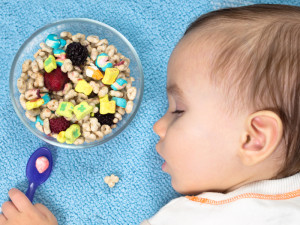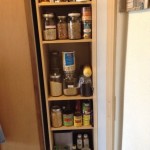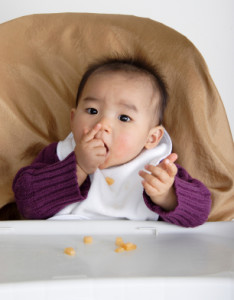Can Kids Have Too Much Fruit?
/Here’s what a Mom recently asked me: "I have what may be a silly question. Should I be concerned with my 8 month old getting too much fruit? In other words, can kids have too much fruit?
Can Kids Have Too Much Fruit?
In a word: yes. Let me expand with 2 key points.
- All of us (i.e. adults too) can get diarrhea from eating too much fruit at once. If your child’s stools are getting loose, then it's a sign of too much fruit.
- Of course, fruit is a healthy food. But human beings need a wide variety of foods from all the food groups to meet our nutrition needs.
In particular, for babies, toddlers and preschoolers, iron is a key nutrient that we’re looking to provide through food. Fruit is low in iron. It’s recommended that you offer iron-rich foods twice a day.
It’s normal for kids to have food preferences. However, kids aren’t at a developmentally ready to understand that human beings can’t survive on a favourite food alone until they’re well into their school-age years.
How to Make Sure Your Child Doesn't Get Too Much Fruit
If you notice that your child will always choose one or two favourite foods, I recommend starting a technique that I call “controlling what’s on the menu”.
Here’s how. You choose what foods you will offer, i.e. what foods are on the menu, at meals and snacks. Your child gets to choose what they’ll eat from what you’ve provided. And, they get to control how much of each food they eat (yes, including zero bites).
This way you are creating a situation where your child eats a balance of food groups throughout the day. And, your child gets to express themselves by controlling what they eat from what you’ve provided. You’ve created an environment where you’re making sure that your child is getting good nutrition at the same time as your child’s personal boundary with their body is respected.
For example, for this mom’s 8 month old, at one solid food time each day serve an iron-rich food either on it’s own, or with another food that isn’t fruit – maybe it’s a vegetable or a grain. Feel free to offer fruit at the other solid food time where you’re offering the iron-rich food. If your child eats a particularly huge amount of fruit one day and you notice that his stools are loose, hold off offering fruit for a day or two. Create balance by offering vegetables, protein foods, and grains.
Get child nutrition tips delivered directly to your inbox. Sign-up for my e-newsletter.










 Recently a parent asked me this question: “How much cow’s milk to offer toddlers. Do you allow them to regulate/drink as much as they want or just fill the cup up once and then when it's empty that's it? Being only 17 months, he can fill up pretty quick on milk during the meal, but I also don't want to be taking it away. I would prefer to just allow him to self regulate, but not sure what to do once the sippy cup is empty.”
Recently a parent asked me this question: “How much cow’s milk to offer toddlers. Do you allow them to regulate/drink as much as they want or just fill the cup up once and then when it's empty that's it? Being only 17 months, he can fill up pretty quick on milk during the meal, but I also don't want to be taking it away. I would prefer to just allow him to self regulate, but not sure what to do once the sippy cup is empty.”
 {
{
 It happened again yesterday. I was leading a workshop and a parent asked me: “Is it wrong to give my child smoothies with veggies in them? Is this considered hiding veggies?” Rarely a workshop goes by without a parent asking me about smoothies for their picky eater kids. They’re such a popular trend these days. While I touched on this in last week’s blog post; it’s such a common question that I get about healthy snacks for kids that I thought that it was worthwhile to expand on it today. And, share some ideas for smoothie ingredients.
It happened again yesterday. I was leading a workshop and a parent asked me: “Is it wrong to give my child smoothies with veggies in them? Is this considered hiding veggies?” Rarely a workshop goes by without a parent asking me about smoothies for their picky eater kids. They’re such a popular trend these days. While I touched on this in last week’s blog post; it’s such a common question that I get about healthy snacks for kids that I thought that it was worthwhile to expand on it today. And, share some ideas for smoothie ingredients. I shared this post previously with the
I shared this post previously with the  You’ve probably heard that it’s great to get your kids to help you in the kitchen to learn cooking skills, instill healthy eating habits, and more.
You’ve probably heard that it’s great to get your kids to help you in the kitchen to learn cooking skills, instill healthy eating habits, and more. March is Nutrition Month!
March is Nutrition Month! {Guest post I contributed to the
{Guest post I contributed to the  Thank you to the parent at a recent workshop in Victoria BC who asked this baby feeding question: "What does it mean when I see whole pieces of food in my baby’s poop?" It’s amazing the topics of conversation that you have once becoming a parent, eh?!
This Mom had recently started feeding her baby finger foods and was seeing pieces of food in her baby’s diaper. It’s often not talked about, but when you start to feed your baby solid foods, you will see a change in their bowel movements.
Thank you to the parent at a recent workshop in Victoria BC who asked this baby feeding question: "What does it mean when I see whole pieces of food in my baby’s poop?" It’s amazing the topics of conversation that you have once becoming a parent, eh?!
This Mom had recently started feeding her baby finger foods and was seeing pieces of food in her baby’s diaper. It’s often not talked about, but when you start to feed your baby solid foods, you will see a change in their bowel movements. Kids begging for food while you're cooking. Do you experience this common situation? You rush home from work and daycare pick-up, drop your bag and coat, and immediately get to work in the kitchen making dinner (or should I say figuring out what’s for dinner and then making it?). As you’re cooking, your little one suddenly is famished. They’re underfoot, claiming that they’re “staaaarrrvvving” and begging you for something to eat. Saying that they couldn’t possibly wait the 10 minutes until dinner is ready.
Kids begging for food while you're cooking. Do you experience this common situation? You rush home from work and daycare pick-up, drop your bag and coat, and immediately get to work in the kitchen making dinner (or should I say figuring out what’s for dinner and then making it?). As you’re cooking, your little one suddenly is famished. They’re underfoot, claiming that they’re “staaaarrrvvving” and begging you for something to eat. Saying that they couldn’t possibly wait the 10 minutes until dinner is ready.